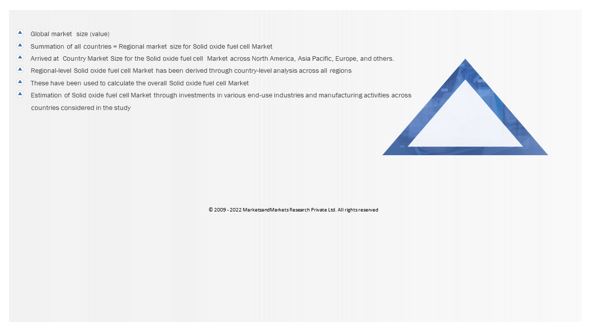The solid oxide fuel cell market size will grow to USD 6.5 billion by 2027 from USD 1.5 billion in 2022, at a CAGR of 33.9 % during the forecast period. Government subsidies and increased R&D on fuel cell programs; fuel flexibility and increasing demand for energy-efficient power generation and stringent emission norms are likely to drive the solid oxide fuel cell market. Rising distributed power generations applications across regions and increasing adaptivity by end users in data centers and military sectors will be the main opportunities growing in market. Asia Pacific is estimated to be the largest market from 2022 to 2027 and is expected to see a high demand for solid oxide fuel cell due to the high demand for fuel cell power generation, as well as increasing research and development for hydrogen generation. The region faces a tough challenge to reduce its carbon footprint from various fossil-fuel-powered operations, including power generation. Asia Pacific is one of the leading markets that has adopted green technologies to meet the targets set by the governments for reducing GHG emissions. Furthermore, countries such as Japan and South Korea are increasing their investments to adopt SOFC technology.

A few major players that have a wide regional presence dominate the solid oxide fuel cell market. The leading players in the solid oxide fuel cell market include Bloom Energy(US), Mitsubishi Power(Japan), Aisin Corporation (Japan), Hitachi Zosen Corporation(Japan), and Ceres (UK). Major strategies adopted by these players include product launches, acquisitions, collaborations, partnerships, sales contracts, mergers, agreements, joint ventures, expansions, and investments. Collaborations, partnerships, joint ventures, and Others were the most commonly adopted strategy from January 2017 to February 2022.
Commercial & industrial segment is expected to be the largest solid oxide fuel cell market, by end-user industry, during the forecast period.
The market is segmented, by end-user, into commercial & industrial, data centers, military & defense, and residentials. The commercial & industrial segment accounted for the largest solid oxide fuel cell market share in 2021. Increased demand for clean energy generation is expected to drive the market. The commercial and industrial segment held a 42.8% share in 2021 of the global solid oxide fuel cells market. Commercial and industrial end users include hospitals, hotels, shopping center malls, office buildings, sports centers, transportation and various others industrial facilities.
Download PDF Brochure – https://www.marketsandmarkets.com/pdfdownloadNew.asp?id=39365796
This research report categorizes the solid oxide fuel cell market based on Type, Application, End User, and Region.
Based on the type:
- Planar
- Tubular
Based on the application:
- Portable
- Stationary
- Transport
Based on the end user:
- Commercial & Industrial
- Data Centers
- Military & Defense
- Residentials
Based on the region:
- North America
- Asia Pacific
- Europe
- Rest of the world
North America: The largest region in the solid oxide fuel cell market in the year 2021.
The region has been segmented, by country, into US and Canada. US is the largest and fastest-growing market in the region. The growth in this country can be attributed to the high demand for fuel cell power generation, as well as increasing research and development for hydrogen generation. In addition, government policies and subsidies, including the Department of Energy’s (DoE’s) Solid State Energy Conversion Alliance (SECA) Program, are the prime driving factors for growth in the US market.
Request Sample Pages – https://www.marketsandmarkets.com/requestsampleNew.asp?id=39365796
Report Objectives
- To define, describe and forecast the global solid oxide fuel cell market by type, application, end-user, and regions
- To provide detailed information regarding the major factors, such as drivers, restraints, opportunities, and industry-specific challenges, influencing the growth of the market
- To strategically analyze the market with respect to individual growth trends, future prospects, and the contribution of each segment to the market
- To strategically profile key players and comprehensively analyze their market shares and core competencies
- To track and analyze competitive developments such as contracts & agreements, expansions, new product launches, mergers & acquisitions, and partnerships & collaborations in the solid oxide fuel cell market
